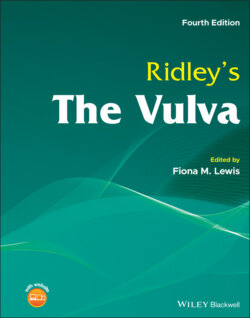Читать книгу Ridley's The Vulva - Группа авторов - Страница 100
AGMLGs
ОглавлениеIt was originally thought that mammary tissue seen in the vulva was an embryological remnant of the mammary ridge. The AGMLGs were first described by van der Putte [31], and it is now clear that they are a distinct entity and are a normal component of anogenital skin [32]. They are found predominantly in the interlabial sulci of the vulva and have distinctive morphological, histological, and immunohistochemical features that are similar to the breast [33].
The morphology of the glands ranges from a simple wide duct with a few small diverticula to a complicated, convoluted tubular system that have features similar to those seen in the breast but without the lobules (Figure 2.17). Most glands, however, consist of a coiled duct with diverticular extensions at irregular intervals along their length. The glands all have a straight excretory duct that opens directly onto the skin surface. The anogenital glands extend to 3.9 mm into the dermis, which is deeper than eccrine or apocrine glands [34]. They are lined by simple columnar epithelium resting on a layer of myoepithelium. The columnar epithelium extends into the straight excretory duct until a short distance from the surface and then gives way to non‐keratinised, stratified squamous epithelium without a myoepithelial layer. The lining epithelium may show columnar cell change in these AGMLGs [34].
Figure 2.17 Lobulated anogenital mammary‐like gland with compact columnar epithelium
(courtesy of Dr James Scurry).
